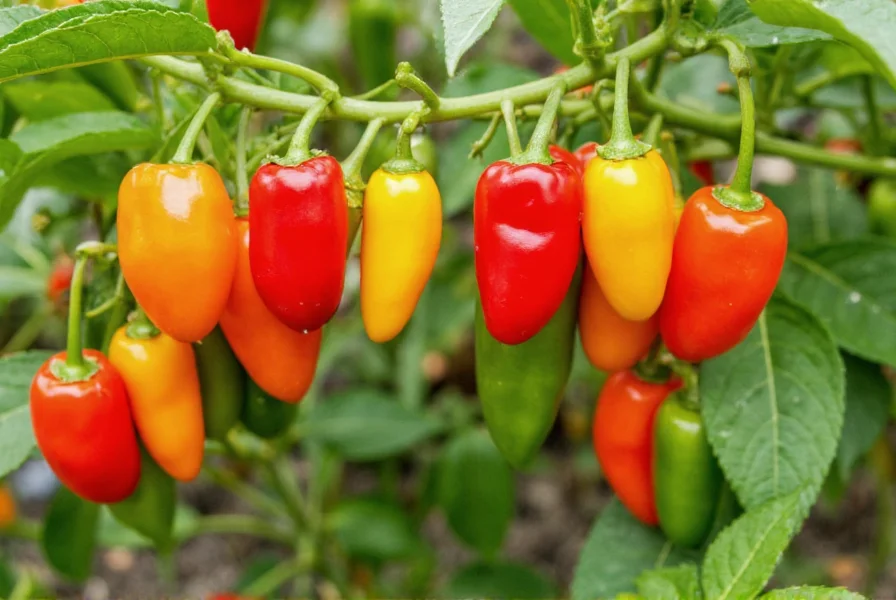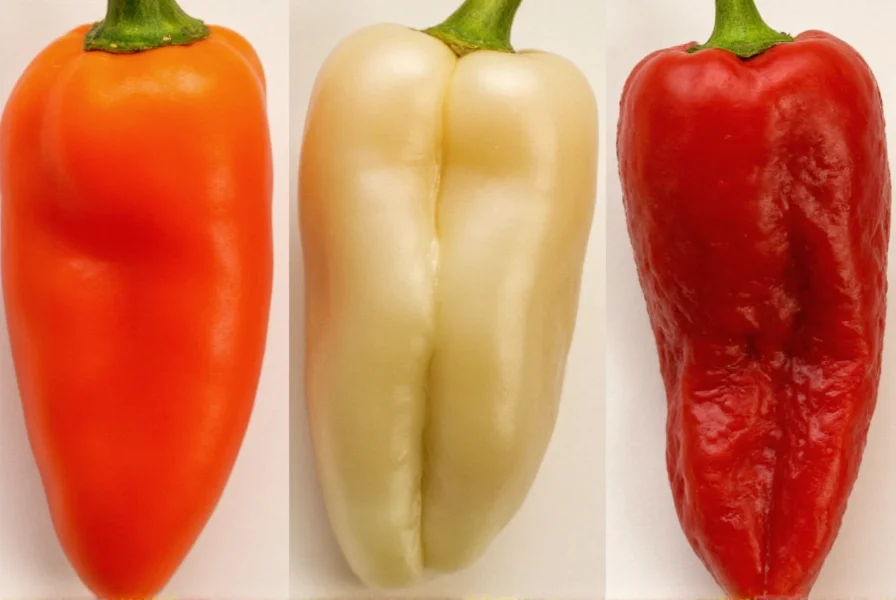Understanding Pepper Classification
While the term “breeds” applies to animals, peppers—members of the Capsicum genus—are categorized as varieties or cultivars. Five primary species form the foundation of cultivated peppers:
| Species | Common Varieties | SHU Range | Origin |
|---|---|---|---|
| C. annuum | Bell, Jalapeño, Serrano | 0–50,000 | Mexico |
| C. chinense | Habanero, Ghost, Reaper | 100,000–2,200,000 | Amazon Basin |
| C. frutescens | Tabasco, Malagueta | 30,000–50,000 | Central America |
| C. baccatum | Aji varieties | 30,000–100,000 | Andes Mountains |
| C. pubescens | Rocoto, Manzano | 2,500–25,000 | South America |
Popular Pepper Varieties by Heat Level
Understanding Scoville Heat Units (SHU) is essential when selecting pepper varieties. This measurement quantifies capsaicin concentration—the compound responsible for heat.
Mild Varieties (0–5,000 SHU)
Bell peppers (0 SHU) offer crisp texture and sweet flavor without heat, making them ideal for salads and stuffed dishes. The Pimento (100–500 SHU) provides gentle warmth perfect for cheese spreads. Gardeners seeking sweet pepper cultivars for container gardening often choose varieties like 'Lunchbox' or 'Gourmet' bells.

Medium-Heat Varieties (5,000–30,000 SHU)
Jalapeños (2,500–8,000 SHU) remain America's most popular hot pepper, versatile for pickling, stuffing, or salsas. The Serrano (10,000–23,000 SHU) delivers brighter heat preferred in Mexican cuisine. For gardeners in cooler climates, reliable jalapeño cultivars like 'Early Jalapeño' or 'Jalafuego' provide consistent yields.
Hot Varieties (30,000–100,000 SHU)
Cayenne (30,000–50,000 SHU) peppers excel in dried form for spices and hot sauces. The Tabasco (30,000–50,000 SHU) forms the base of the famous sauce, requiring fermentation for optimal flavor. Gardeners interested in growing traditional Tabasco pepper varieties should note their preference for humid conditions.
Extreme Heat Varieties (100,000+ SHU)
Habaneros (100,000–350,000 SHU) offer complex fruity notes alongside intense heat. The Ghost Pepper (855,000–1,041,427 SHU) gained notoriety as one of the first commercially available super-hots. Currently, the Carolina Reaper (1,400,000–2,200,000 SHU) holds the Guinness World Record as the world's hottest pepper variety.

Growing Considerations for Different Pepper Types
Successful cultivation requires matching pepper varieties to your climate. Most peppers need 70–90 frost-free days and temperatures between 70–85°F (21–29°C). C. chinense varieties like habaneros thrive in tropical conditions, while C. annuum types such as bells adapt better to temperate zones.
When selecting best pepper varieties for home garden projects, consider these factors:
- Space requirements: Compact varieties like 'Thai Hot' work well in containers
- Disease resistance: Look for labels indicating TMV (tobacco mosaic virus) resistance
- Maturity time: Short-season varieties suit cooler climates
- Intended use: Thick-walled peppers like 'Hungarian Wax' excel for roasting
Culinary Applications of Pepper Varieties
Different pepper types contribute unique characteristics to dishes. Understanding culinary uses of various pepper cultivars elevates cooking:
- Sweet bells: Ideal for salads, stir-fries, and stuffed peppers due to mild flavor
- Jalapeños: Perfect for salsas, nachos, and pickled preparations
- Habaneros: Complement tropical fruits in sauces and marinades
- Chiltepin (wild C. annuum): Adds smoky depth to Southwestern dishes
Chefs seeking authentic Mexican pepper varieties often use fresh serranos in pico de gallo and dried guajillos in mole sauces. For preserving, thick-walled varieties like 'Anaheim' perform better than thin-skinned cayennes.
Selecting Peppers for Your Garden
Choosing the right varieties depends on your goals and conditions. For beginners, easy-to-grow pepper cultivars like 'California Wonder' bell or 'Hungarian Hot Wax' offer reliable results. Experienced gardeners might experiment with heirloom varieties such as 'Aji Limón' for unique citrus notes.
Consider these tips when planning your pepper garden:
- Start seeds indoors 8–10 weeks before last frost
- Use soil thermometers to ensure planting when soil reaches 65°F (18°C)
- Rotate crops annually to prevent soil-borne diseases
- Provide consistent moisture to prevent blossom end rot
Frequently Asked Questions
What's the difference between pepper varieties and species?
Pepper species (like C. annuum or C. chinense) represent distinct biological classifications with different genetic backgrounds. Varieties are cultivated subtypes within a species—for example, 'Jalapeño M' and 'Jalapeño Early' are varieties of C. annuum. Understanding differentiating pepper species for cultivation helps gardeners select appropriate growing conditions.
Which pepper variety is best for beginners?
For novice gardeners, bell peppers like 'Gypsy' or 'Lunchbox' offer reliable yields with no heat to manage. If you prefer some spice, 'Hungarian Hot Wax' provides moderate heat (5,000–10,000 SHU) with high productivity. These beginner-friendly pepper cultivars tolerate minor care mistakes better than super-hots.
How do I preserve different pepper varieties?
Preservation methods vary by variety. Thick-walled peppers like bells and poblanos excel when roasted and frozen. Thin-skinned varieties such as cayenne work best dried for powders. For long-term storage of diverse pepper types, consider freezing whole peppers in airtight containers or making vinegar-based hot sauces that highlight each variety's unique flavor profile.
Can I cross-pollinate different pepper varieties?
Yes, but only within the same species. C. annuum varieties (like bells and jalapeños) can cross-pollinate, but C. annuum won't cross with C. chinense (habaneros). Gardeners growing multiple pepper varieties in close proximity should separate different species by 500 feet or use physical barriers to maintain variety purity if saving seeds.
Why do some pepper varieties change color as they ripen?
Color changes indicate ripening stages and increased sugar content. Most peppers start green (unripe) and mature to red, yellow, orange, or purple. For example, bell peppers develop higher vitamin C levels when allowed to ripen to their final color. Understanding pepper ripening stages for optimal harvest ensures peak flavor and nutritional value.











 浙公网安备
33010002000092号
浙公网安备
33010002000092号 浙B2-20120091-4
浙B2-20120091-4